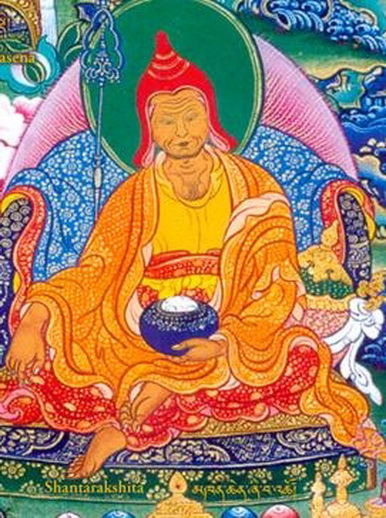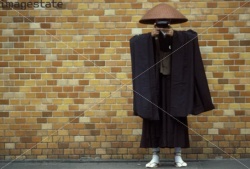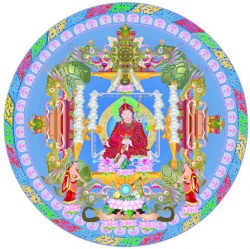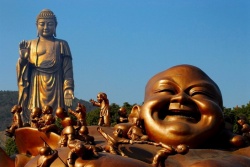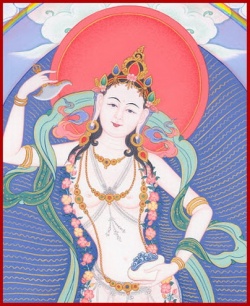Shantarakshita
Shantarakshita (Skt. Śāntarakṣita; Tib. ཞི་བ་འཚོ་, Shyiwa Tsho, Wyl. zhi ba 'tsho), also called Khenpo Bodhisattva, ‘Bodhisattva Abbot’. This great Indian pandita of the Mahayana school was abbot of the Buddhist university of Nalanda. He was invited to Tibet by King Trisong Detsen where he founded the temple and monastery of Samyé and ordained the first seven Tibetan monks, thus establishing the Tibetan Sangha, according to Nagarjuna’s Sarvastivadin tradition. He worked extensively to uphold and maintain the Buddhist teachings, and so began to establish the Buddhadharma in Tibet. However, indigenous forces that opposed and were hostile to the Dharma were increasing in strength. Neither the might of the king, Trisong Detsen, nor the power of the great abbot Shantarakshita could subdue them, and so they invited Guru Rinpoche to come to Tibet.[1]
Writings
Footnotes
- ↑ See pages 13-14 and 32-33 of A Great Treasure of Blessings.
Further Reading
- Śāntarakṣita: His Life and Work, edited by Hari Shankar Prasad (collected articles in Hindi, English and Tibetan), Tibet House, New Dehli, 2003.
- Lobsang N. Tsonawa, Indian Buddhist Pandits from The Jewel Garland of Buddhist History, Dharamsala: Library of Tibetan Works and Archives, 1985.
- David Seyfort Ruegg, The Literature of the Madhyamaka School of Philosophy in India, Wiesbaden: Harrassowitz, 1981, pp. 88-93
External Links
Source
The deputy of the Buddha, the holy Shantarakshita,
And the superior master of incantations, the
ascetic Padmasambhava,
Kamalashila, the crest jewel of the wise,
And Trhisong Detsen. of surpassing thoughts –
Through these four, like sunrise in the dark land of Tibet,
The light of holy religion spread even to the frontiers.
These holy men of unwavering kindness
Tibetans will all forevermore revere.
Tibetan Song
The history of the Land of Snows is as mysterious as its awesome landscapes, as secret as its fastnesses. It reaches back from chronicle to legend and then to myth, beyond which an impenetrable veil hides the distant past. Ringed by lofty mountains, Tibet was for millennia isolated from the political intrigues of its neighbours to the south, east and west. China's cultural insularity ensured that its historians paid scant attention to Tibet, and the great northern peoples, including the Mongolians, remain almost as enigmatic and remote as the Tibetans themselves. Trans-Himalayan culture was deeply rooted in the oral tradition, and the Tibetan people kept no ordinary written records until the advent of Buddha's teaching.
According to the Tibetans, the first human beings were as radiant and ethereal as the original earth. Gradually the earth condensed and the bodies of men grew dense as well, until both reached their present condition. Sometime during this long evolution Avalokiteshvara in the form of a monkey mated with a terrestrial demoness of the rocks, and their offspring became the ancestors of the Tibetans. Avalokiteshvara gave his children six kinds of grain, and over time this race evolved from a monkey-like appearance into modern human forms. At the same time, society evolved, though disputes over food formed the basis of all the inequities and injustices that sprang up with social progress. Six races emerged, to which a seventh race, directly descended from the primordial egg of heaven, was added. Seven ages of human development culminated in the emergence of the first heavenly king. The first five periods were characterized by the appearance of various classes of lesser deities, and the sixth was marked by the rule of the twelve minor kings. These chieftains were not strong enough, individually or collectively, to rule Tibet and to protect it from the great powers at the four cardinal points – China, India, Iran and Gesar – but they were wise enough to discern the need for a mighty ruler.
Having come together and worshipped the holy mountain, the twelve kings sent messengers up the mountain to heaven to petition for a single monarch. According to ancient scrolls found in the Tun-huang caves, "The divine king of Great Tibet, of magical power, came from the gods as ruler of man", and the seventh age began. This line of seven divine kings ruled the earth by day but returned to their natural abodes at night by ascending the dmu, a rope whose name means 'sky'. When the first king's son reached the age of thirteen, the king's body dissolved into the dmu and the rope returned to heaven. Each successor followed the same practice, and so there are no tombs for the divine kings save for the dmu tombs, the celestial vault. Trigum, the last king in the line, was an exception, however. Though still of celestial origin, he had an arrogant personality and he once challenged all comers to a duel in magic. Only one man dared to accept the challenge, and in their ferocious contest first near Mount Kailas and, later, renewed southwest of Lhasa, the king accidentally severed his dmu. The rope rose to heaven and Trigum became the first king to leave a corpse. Though one of his sons, Rula-kye, later overthrew the challenger and ascended the throne, the line of divine kings had come to an end.
Rula-kye built mountain fortresses, baled hay, introduced charcoal and the smelting of metals, and taught the people to make ploughs and yokes. For the first time, Tibetans had ploughed fields and built bridges over otherwise impassable waterways and a system of channels for irrigation. According to tradition, the Bon religion in its pure form entered Tibet at this time from Iran, or from Gilgit or Gurnawatra (northwest India). The art of religious story-telling and that of singing genealogies and riddles also appeared during this period. Rapid social and agricultural progress initiated by Rula-kye continued under the six human kings of the Lek dynasty, but the eight kings of the succeeding De dynasty focused their attention upon the development of law and the political order. With the death of the last Dc king, the queens of Tibetan monarchs ceased to be incarnate goddesses, and the subsequent kings of the Tsen dynasty married among their subjects, at once diluting and sharing the divine inheritance. When the fifth and last Tsan king ascended the throne, a casket descended from heaven containing two Buddhist sutras and a golden stupa. Though no one could read the sacred texts, they were preserved and revered as the "Mysterious Helper", and the king was vouchsafed a prophecy that during the fifth reign after his, the meaning of the heavenly casket would be known.
The fifth king of the prophecy was the great Songtsen Gampo, who gave Tibet a firm and unified political structure and accepted the Buddhadharma. Born about A.D. 569, he ascended the throne at age thirteen. Establishing legal codes throughout Tibet, he subjugated the petty chieftains and formed a single army of a hundred thousand men. He brought water mills, silkworms and mulberry trees, paper and ink, from China and adapted the Chinese calendar, but he turned to India for a system of writing. Marrying a Nepalese princess, he accepted her Buddhist faith and built temples in Lhasa for the images she brought to Tibet of Akshobhya, Maitreya and Tara, and the image of Akshobhya survives into the present. Songtsen Gampo also married a Chinese princess who was a Buddhist, and she brought an image of Gautama Buddha, originally made in Magadha, and a temple was built for it. He built the first structures of the Potala in Lhasa and founded a number of monasteries which were not successful. His stunning invasion of India and China made Tibet an Asian power that could not be ignored. Diplomats and soldiers came to Lhasa, trade flourished, China and Nepal paid annual tribute to the king, and some sacred texts were translated into Tibetan. Within two or three decades Tibet became a literate nation, a military power and nominally a Buddhist country. When Songtsen Gampo died in 650, Tibetans had already come to believe that he was an incarnation of Avalokiteshvara. His Nepalese wife was recognized as the green Tara, whilst the Chinese princess was seen to be the white Tara (Kwan-Yin).
Though Buddhist thought and practice waned and fell into degradation after the death of Songtsen Gampo, traditions hint at a much older stream of Bodhi Dharma, the secret Wisdom Religion, that had abided in the Himalayas and the Gobi Desert from the beginning of man's spiritual awakening. Perhaps this is why the most arcane teachings of Gautama Buddha rooted themselves in Tibet when the Good Law came there. For the time being, however, a succession of rulers had to fight just to preserve the integrity of Tibet against Chinese incursions, North Indian revolts and internecine disputes. In 742 a Chinese wife of the reigning king gave birth to Trhisong Detsen, who ascended the throne in 755. Tibet's dwindling fortunes were now reversed. The Pala kings of Bengal became tributaries of Tibet, and Trhisong Detsen extended his borders to the Ganges, where he set up an iron column to mark his frontier. He invaded China and even enthroned a new emperor who ruled briefly, and he generally secured Tibet against the outside world. Then he turned his attention to Buddha's teachings and decided to adopt the religion and make it the religion of his country. His lifelong labours for Buddha's teaching led to his being recognized as an incarnation of Manjushri, Bodhisattva of wisdom.
Trhisong Detsen knew that Bon priests opposed most aspects of the Buddhist tradition, and so he did not attempt to force acceptance upon the people. Quietly, he sent emissaries to Nalanda to seek help. Tibetan tradition holds that at that time Shantarakshita was Upadhyaya of the great university and monastic community, though he was met by the Tibetans in Nepal. Shantarakshita may have been born in Bengal, the son of a king of Zahor, and though nothing is known of his early life, he was an ordained monk who combined a remarkably logical mind with a deep understanding of tantric magical practices. He had written the Tattvasamgraha, a sweeping analysis from the Yogachara standpoint of every known Buddhist and non- Buddhist philosophical tenet. The Tibetan emissaries who interviewed him were deeply impressed by his intelligence, erudition, energy and will. Lengthy discussions followed in which Shantarakshita came to a full understanding of the possibilities and limitations of working in Tibet. Despite his immense learning and renowned skill in dialectical disputations, he was determined to explain the fundamentals of Buddha's teachings to Tibetans. Trhisong Detsen's ministers, however, were sharply divided over the importation of Buddhist doctrines. Some strongly supported the king, whilst others backed the Bon resistance to any change in Tibetan culture. Shantarakshita patiently waited in Nepal until the balance of opinion shifted to the king's party, and only then he made the arduous journey to Lhasa in response to a royal invitation.
Shantarakshita, who is called in Tibet Shiba-'tsho, Shantijiva and, simply, Bodhisattva, was warmly received in Lhasa. The king, however, wished to be assured that his choice had been wise before supporting the monk's proposed programmes. He knew that the monks surviving from Songtsen Gampo's time were lax in respect to practices and austerities and often shockingly dissolute. He did not want to infect Tibet with another of that breed. The deputies sent to interview Shantarakshita did not understand his language and considerable consternation resulted. Eventually, Ananta of Kashmir offered his services as interpreter, and soon the deputies could report that Shantarakshita "was virtuous and had no obscene thoughts". He was invited to the palace and received by the king. According to one Tibetan historian, when Shantarakshita was asked about his doctrine, he replied:
- My doctrine is to follow whatever proves correct under examination by reason, and to shun all that does not agree with reason.
The king was convinced of the soundness of his decision by Shantarakshita's keen mind and impeccable moral conduct. He gave him freedom to preach and to teach in Tibet and offered to support any undertaking the monk might advise.
Perhaps more than the remarkable work Shantarakshita was about to undertake, the stupendous testament to his character might be the change in approach he initiated in his own consciousness. The most brilliant dialectician of his day, he realized that the recondite disputations of which he was the unchallenged master were utterly meaningless to a people who had hardly heard of the Enlightened One and who had discovered the written word barely a century before. He laid aside all his sophisticated learning and undertook basic education in Buddhadharma. With the help of the interpreter Ananta, he spent four months teaching Trhisong Detsen and his court. Beginning with the Four Noble Truths – suffering, its cause, its cessation and the Noble Eightfold Path – he proceeded to explain the six and ten virtues, from dana to the highest attainment of the Bodhisattva. He taught the king about the eighteen states of corporeal existence and expounded the eight fundamental prohibitions.
Then Shantarakshita turned to the twelve nidanas which form the links in the circular chain of conditioned existence. Sentience leads to consciousness (vijnana), and consciousness gives rise to name and form (namarupa). Namarupa in turn produces contact (sparsa), and this in turn leads to emotion (vedana). Feelings arouse thirst or desire (trishna), which produces attachment and revulsion (upadana). The ceaselessly changing tension between attraction and repulsion initiates the condition of existence (bhava), and this makes necessary birth (jati). Birth is the ultimate cause of death, since whatever comes into being must necessarily perish. From old age and death, the inevitable end of all embodied existence, come grief, lamentation, pain, depression and misery. Thus, Shantarakshita taught, the endless chain can be broken only through Buddha's way of Enlightenment. This was the justification of Buddhist practices from meditation and morality to the austere life of the monk.
For the first time, the basic message of Gautama Buddha was taught in Tibet, and the Bon priests felt directly threatened by Buddha's doctrine. In particular, the code of conduct expounded by Shantarakshita came into uncompromising conflict with some Bon practices. Besides bringing considerable political pressure to bear on the king, the Bon priests employed their formidable magical powers. In the words of Bu-ston, they "brought the malignant deities of Tibet into a fury. Phan-than was carried away by a flood, lightning struck Mar-po-ri, and diseases fell upon men and cattle." Soon the people, cunningly guided by the Bon priests, cried out against Shantarakshita, and the king's ministers urged Trhisong Detsen to expel him. When the king discussed the deteriorating situation with Shantarakshita, he expressed concern for the monk's safety. Though he was loath to give up his effort to make Tibet a Buddhist country, he thought it wise to send Shantarakshita away. Shantarakshita saw no value in imposing the Buddhadharma on Tibetans through force, but he devised a plan to preserve and expand the gains already made. He left Tibet for Nepal, and upon his suggestion Trhisong Detsen invited the great tantrist Padmasambhava to Tibet.
Padmasambhava accepted the invitation, understood the situation in Tibet, and engaged in magical combat with the aroused demons. His victories over Bon machinations were softened by his skill in absorbing some Bon traditions into the framework of Buddhist thought and practice. The custom of giving a place to the Bon chief priest in the Dalai Lama's governing council may ultimately date back to Padmasambhava's work. Before long Shantarakshita was able to return in safety to Tibet. Together he and Padmasambhava established the great Samye monastery some thirty miles southeast of Lhasa. Taking the then modern monastery of Odantapuri as a model, they constructed a number of buildings before any monks were chosen. Bu-ston wrote that Shantarakshita "made a plan containing the forms of Mount Sumeru, the twelve continents, both the sun and the moon, and these surrounded by a circumference of iron".
Samye was built about 787; its upper portions were constructed in Chinese style, its middle in Indian style and its foundations in the Tibetan manner. Named "the academy for obtaining the heap of unchanging meditation", Samye became the repository of many Indian texts brought by Shantarakshita, and a number of them survive today. Though Padmasambhava left shortly after Samye was built, Shantarakshita remained for thirteen years and made it into the first full-fledged monastery in Tibet, complete with provisions for resident monks and for teaching and training. Samye naturally became the first important centre for Buddhist learning in Tibet, and it served as a platform from which to promulgate the Good Law across the land.
In the few years left to him, Shantarakshita initiated two lines of work which profoundly affected the subsequent history of Tibet. On the one hand, he trained a group of scholar-monks who could translate Buddhist sutras into Tibetan. At the same time, he persuaded a number of Indian Buddhists to come to Tibet and join in their labour. Difficult as it is to imagine under the adverse circumstances of the time, within a few years Shantarakshita had overseen the translation of most of the over forty-five hundred texts which came to constitute the Tibetan canon, the Kangyur and the Tengyur, the scriptures and the commentaries. On the other hand, Shantarakshita took twelve novices and tested them thoroughly, choosing from them seven for ordination. These revered "seven selected ones" became the core and foundation of Tibetan monasticism. Though there had been ascetics among the adherents of the Bon tradition and even Buddhist monks of a kind, Shantarakshita saw to it that his disciples followed the proper vinaya rules.
Shortly before he died Shantarakshita foresaw a gradually developing conflict within the ranks of the Tibetan monks. Knowing that their disagreements would eventually centre on the nature of the path to Enlightenment and therefore upon the validity of the disciplines he had established, Shantarakshita prophesied that his own Indian disciple, Kamalashila, would come from across the Himalayas and settle the dispute before the king himself. Though he was still healthy, his immense self-sacrifice in the cause of the Buddhadharma in Tibet was finished. He had renounced an ascetic but comfortable existence at Nalanda, where many disciples could appreciate his exceptional intellectual gifts, and like Buddha among the masses, had come to an alien land to raise the edifice of the doctrine and discipline from the beginning. Despite adversity and danger to himself, he had accomplished his chosen mission in a few years, and suddenly one day he was accidentally kicked by a horse and died.
Kamalashila came to Tibet on the invitation of the king and in fulfilment of his teacher's prediction. Even though Chinese Buddhists had supported Trhisong Detsen's attempts to bring Shantarakshita to Tibet, they inclined to a lackadaisical view of monastic discipline and angrily resented the monks who followed Shantarakshita. When Kamalashila challenged them to debate, the king himself chose to preside over it. The Chinese monks argued that all action produces karma and that it is better to do nothing rather than perform good deeds. By abstaining from all deliberate action, Enlightenment is at once assured. Kamalashila replied that discursive wisdom is essential to meditation, the source of prajnaparamita or transcendent wisdom. Studied inaction is a denial of discriminative wisdom, and without it, meditation is little more than a swoon. Without real meditation and the ethical disciplines that support it, Enlightenment is impossible. Having stated his view, the king and chief ministers ruled decisively in favour of Kamalashila's standpoint, and Shantarakshita's teaching became the official doctrine of the Buddhist tradition in Tibet.
There is a stupa in Nepal associated with the central figures in Shantarakshita's life. It is called Bya-rung-kha-shor, which means, "It's all right to do it, he said." Legend says that once Avalokiteshvara wept at the sight of the uncounted multitudes floundering in the ocean of Samsara. He dedicated his tears to the service of humanity. Two of them became daughters of Indra, but one fell out of heaven and was reborn as the daughter of a chicken-keeper in Nepal. Eventually she had four sons, all of whom became moderately prosperous, and late in life she · determined to build a shrine. Since she was a humble keeper of chickens, she sought the king's approval and he readily gave it, saying, "It's all right to do it." She and her sons began to build the stupa but she died before it was complete. Following her wish, the · four sons finished her stupa and placed the relics of the former Buddha Kasyapa in it. Owing to their fidelity to their vows, they were reborn together. One became Trhisong Detsen, another was born as Shantarakshita, the third as Padmasambhava and the fourth as Trhi-sh'er of Ba, who took charge of Shantarakshita's translation program. Thus was mankind, and Tibetans in particular, served by a tear shed from the divine eye of Avalokiteshvara.
